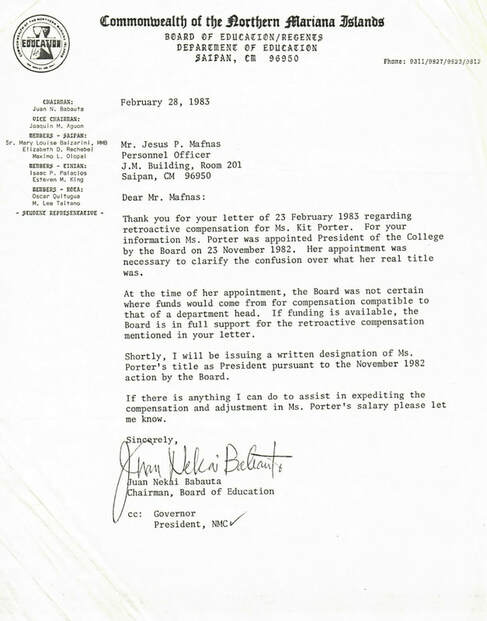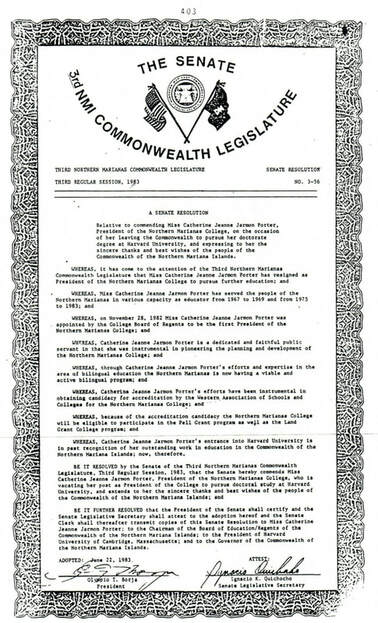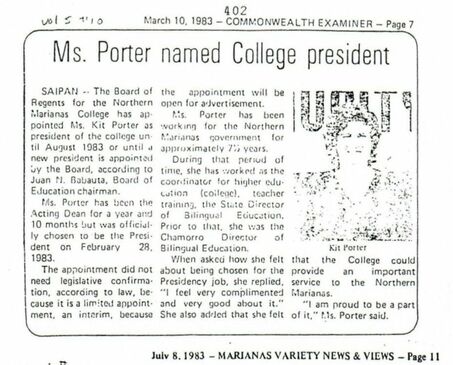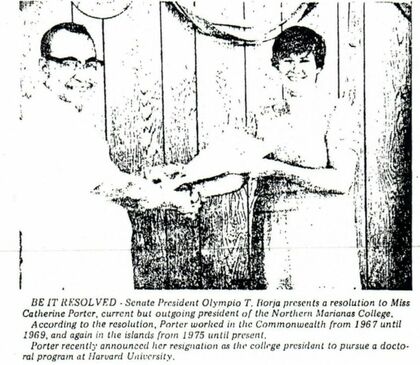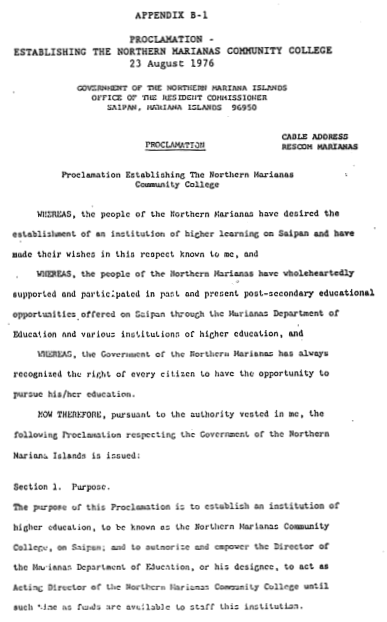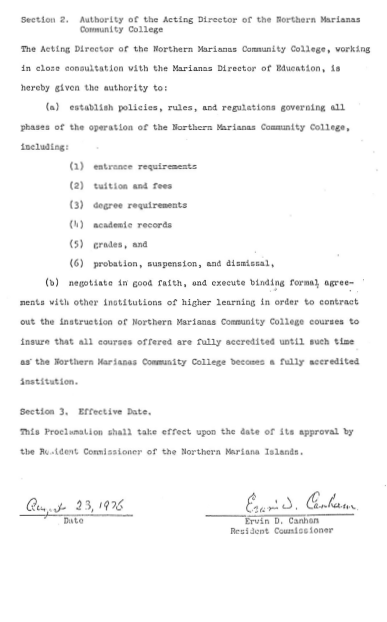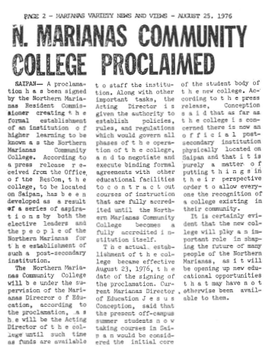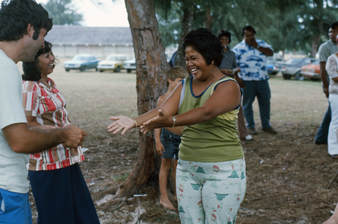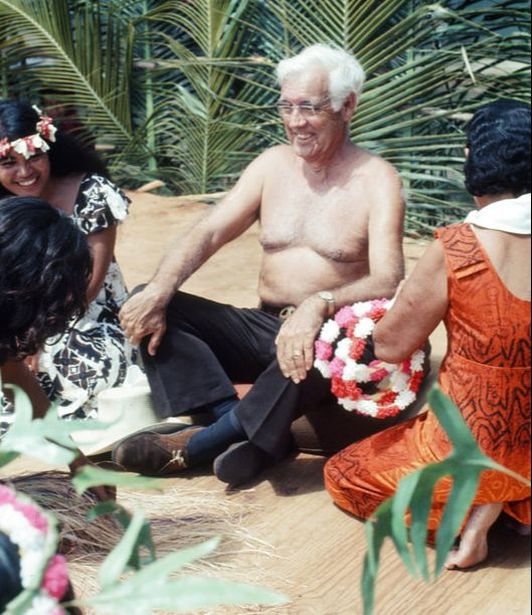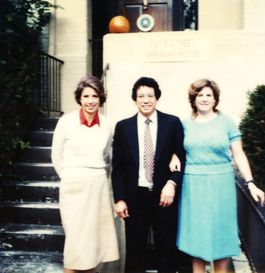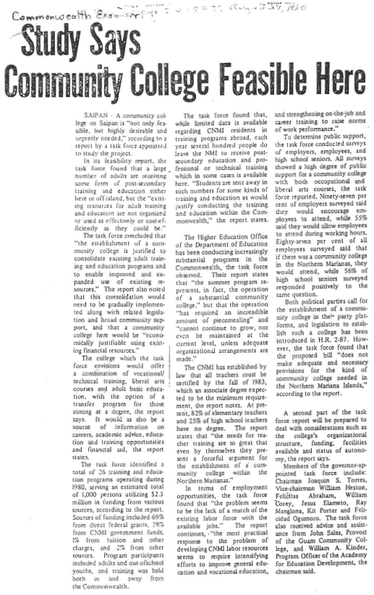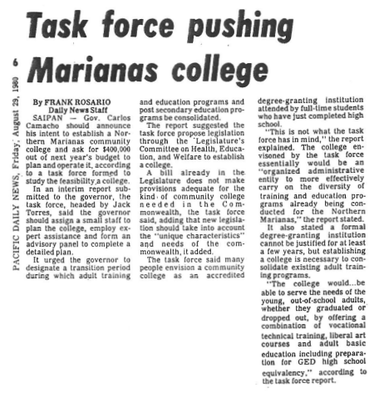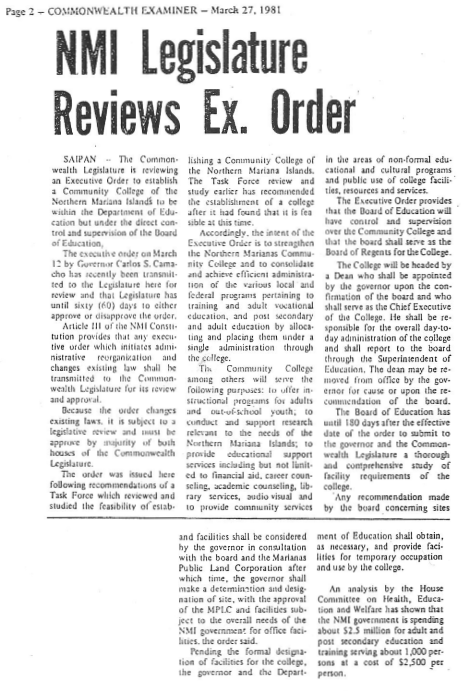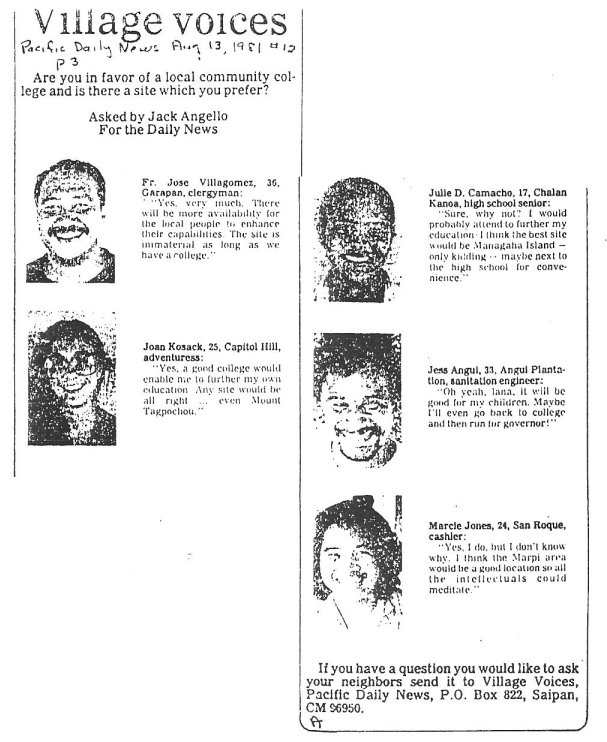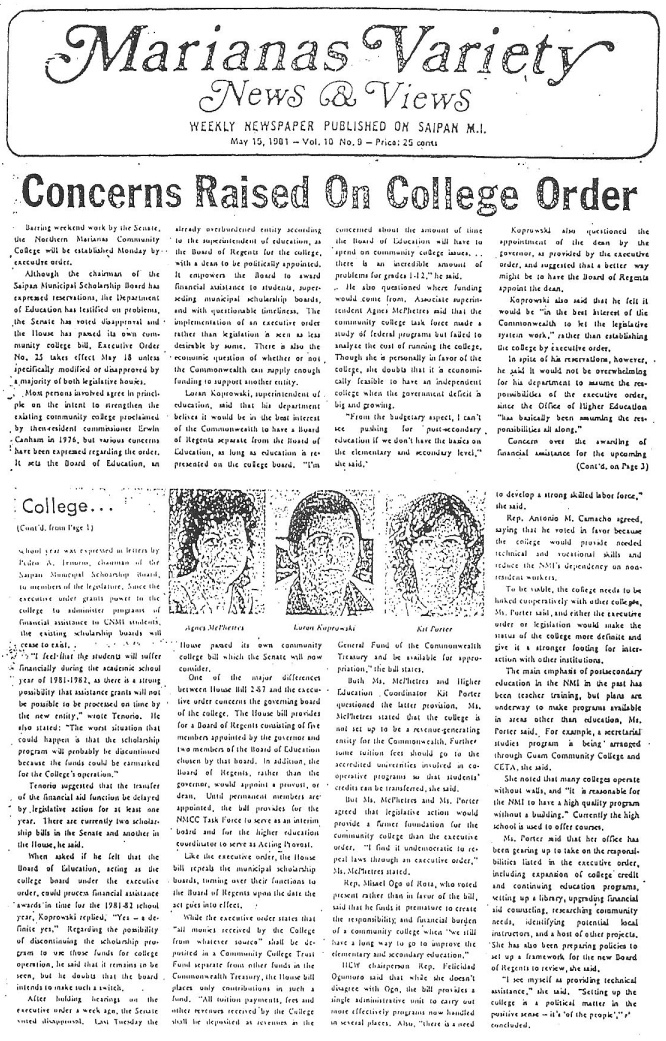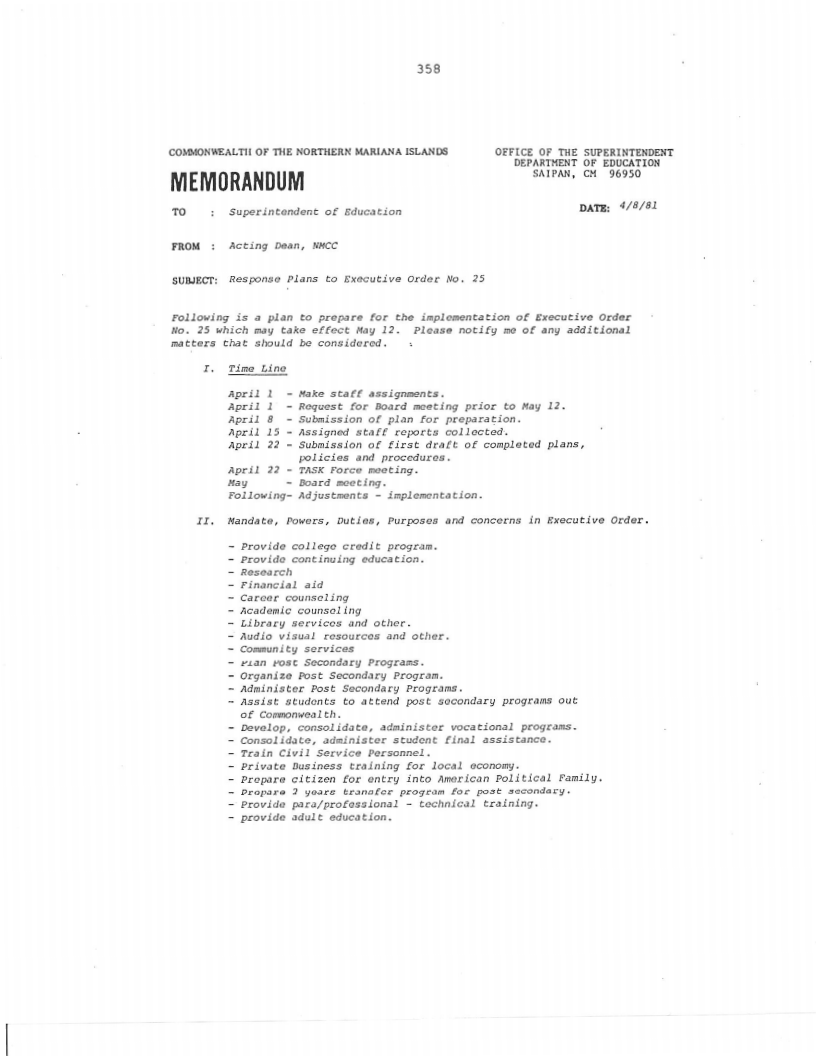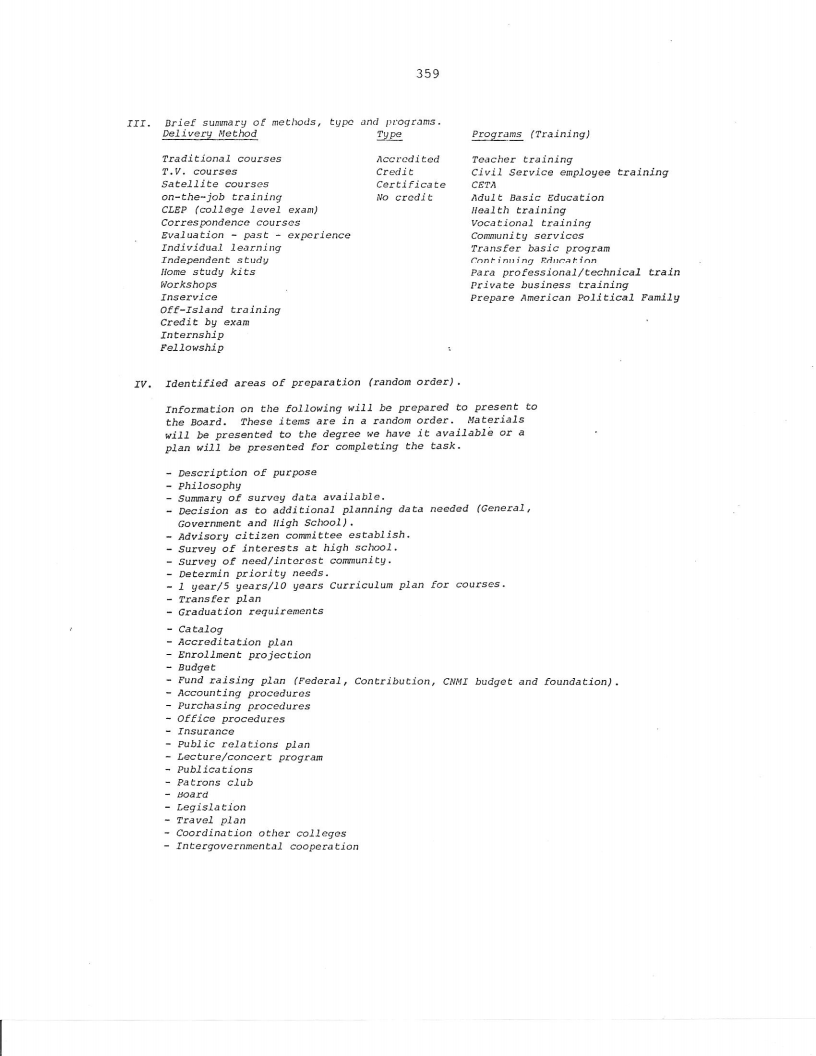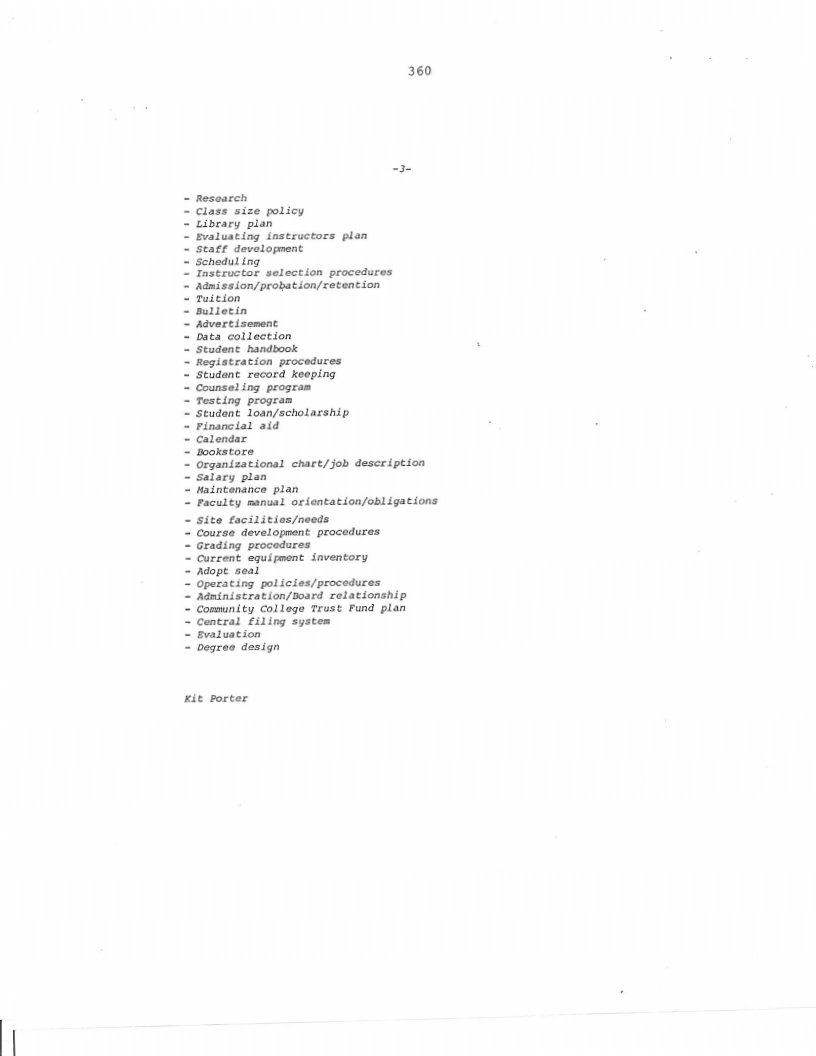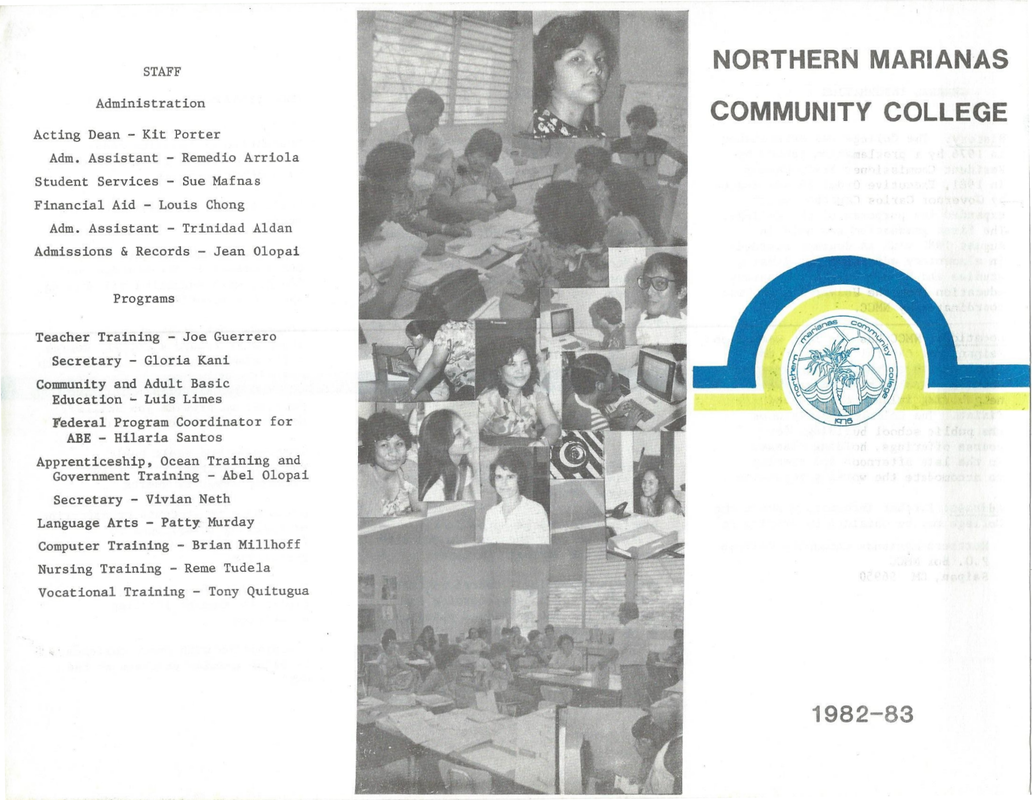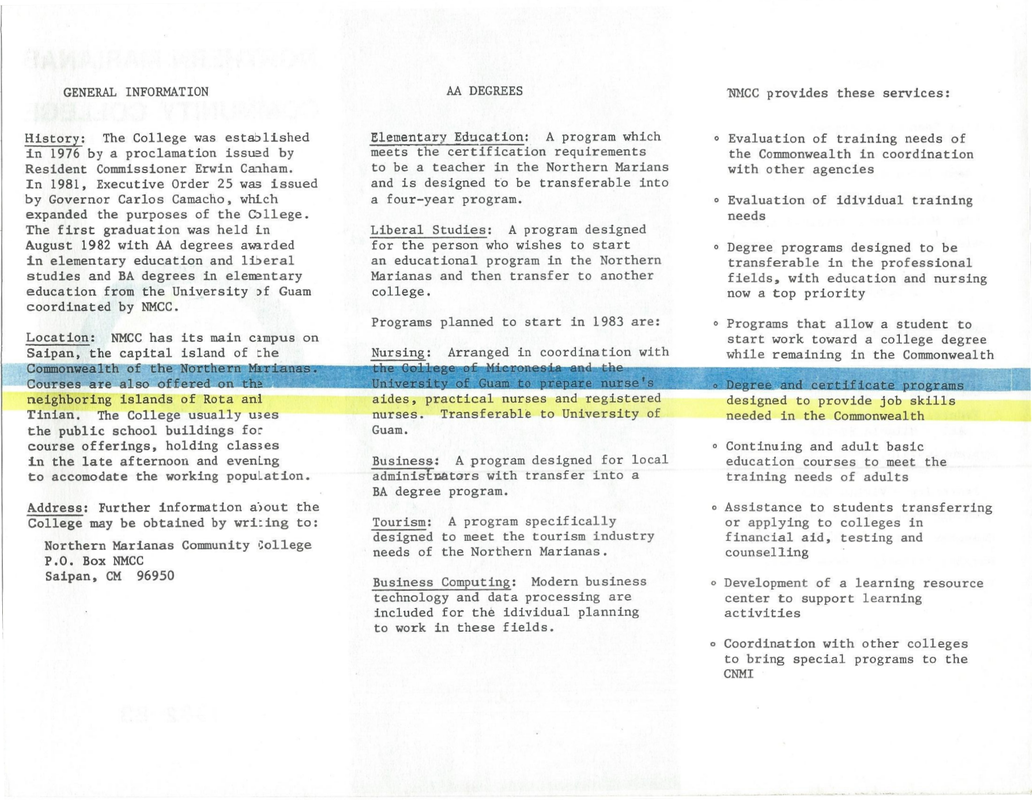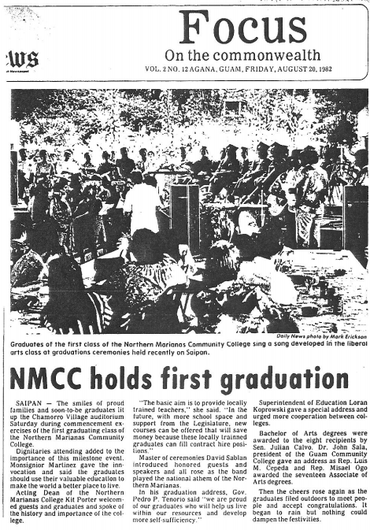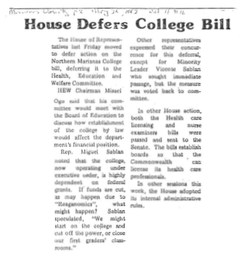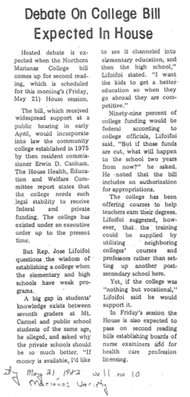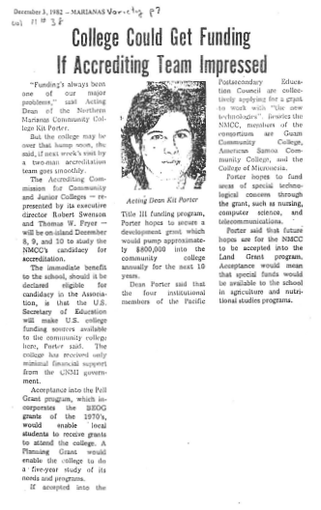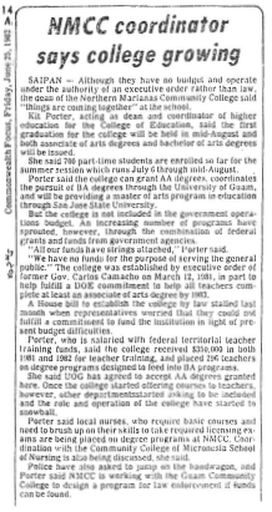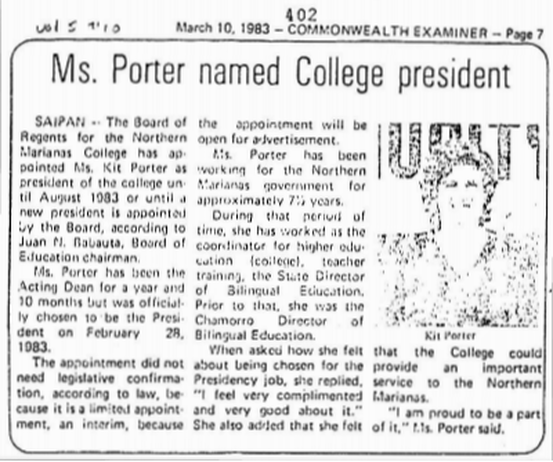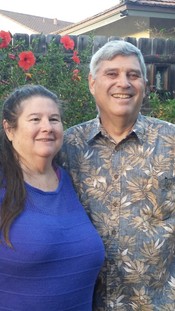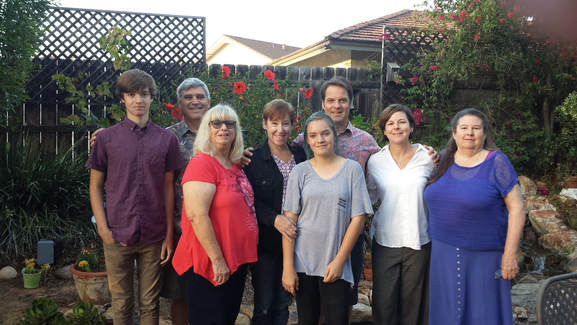Higher Education and
Northern Marianas College
Note from Kit
Last Updated 2/04/19
I have been asked by individuals to “prove” that I was the first president of NMC. In fact, it was a joy for me to establish NMC, be its first president, and achieve my personal goal to have accredited degrees available in the NMI. The title was not important to me until representing the college, obtaining candidacy for accreditation and obtaining funding became difficult without it.
Research shows I was appointed President twice—once by the NMCC Board under Executive Order 25 and later by the NMC Board under Public Law 3-43. The Chief Executive titles in the establishment documents had been: “President” 19 January 1983 Public Law; “Dean” March 12, 1981 Executive Order (11/26/82 amendment proposed change in title from “Dean” to “President.”); “Acting Director” 23 August 1976 Proclamation.
I was also the State Director of Higher Education and represented the Commonwealth at US state level meetings and interactions as well as for US grant funding.
For now, please see the following three documents:
Research shows I was appointed President twice—once by the NMCC Board under Executive Order 25 and later by the NMC Board under Public Law 3-43. The Chief Executive titles in the establishment documents had been: “President” 19 January 1983 Public Law; “Dean” March 12, 1981 Executive Order (11/26/82 amendment proposed change in title from “Dean” to “President.”); “Acting Director” 23 August 1976 Proclamation.
I was also the State Director of Higher Education and represented the Commonwealth at US state level meetings and interactions as well as for US grant funding.
For now, please see the following three documents:
Clair Howard was the NMDOE Coordinator of Higher Education in 1975. In 1976 Don Smith replaced Clair Howard and in 8/23/1976 was named Acting Director of NMCC “Proclamation Establishing the Northern Marianas Community College”
Right now my priority has been adding content from 1967-1969 Rota Peace Corps Volunteer. Will expand this topic when finished sorting materials related to 1975-1983 and NMCC/NMC.
Press article that Ms. Porter “was officially chosen to be the President on February 28, 1983.
A change in plans
Last Updated 5/14/18
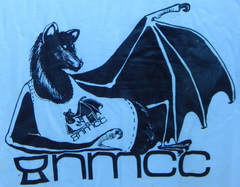 First Mascot of NMCC
First Mascot of NMCC
We are adding content about Northern Marianas College (NMC) before completing materials from the 60's. This is because Kit received an e-mail from Dr. Carmen Fernandez, President of Northern Marianas College, saying:
It is a great pleasure for me to invite you to be the commencement speaker for the 38th Graduation of the Northern Marianas College. As our first president/CEO, it would be a great honor to have you address the class... (May 19, 2018)
In preparation, we have selected some highlights concerning establishing NMC. In the future we hope to include more specific stories, different picture albums and audio recordings of course material and meetings. There are roughly sixteen boxes of reports, document, draft legislation and letters related to higher education that are not inventoried or digitized yet. There are also many audiotapes which have yet to be digitized.
It is a great pleasure for me to invite you to be the commencement speaker for the 38th Graduation of the Northern Marianas College. As our first president/CEO, it would be a great honor to have you address the class... (May 19, 2018)
In preparation, we have selected some highlights concerning establishing NMC. In the future we hope to include more specific stories, different picture albums and audio recordings of course material and meetings. There are roughly sixteen boxes of reports, document, draft legislation and letters related to higher education that are not inventoried or digitized yet. There are also many audiotapes which have yet to be digitized.
Establishing Northern Marianas College: Highlights
Prior to becoming a Commonwealth in 1976, the Northern Mariana Islands (NMI) offered training in the NMI through a variety of sources. As part of the Community College of Micronesia (CCM), courses were offered in the NMI and at other locations with the CCM School of Nursing was located on Saipan. The University of Hawaii researched Micronesian languages and assisted with education and material development. The University of Guam was contracted to provide courses, as did some other schools. Scholarships were available to students who could leave the islands.
Following is a summary of higher education in the TTPI prior to the NMI becoming a Commonwealth. Information on NMI learners was not separated out, but it gives an idea of what was available:
Following is a summary of higher education in the TTPI prior to the NMI becoming a Commonwealth. Information on NMI learners was not separated out, but it gives an idea of what was available:
|
1958 -- No institutions of higher education existed within the Trust Territory except a school of nursing in Koror. Training was also conducted at Central Medical School in Fiji. In-service training was given and a few teachers attended Territorial College in Guam during the summer.
1961 -- Forty-six students received Trust Territory (TT) scholarships. Eleven attended the University of Hawaii (UOH) or other Hawaii institutions, eighteen attended Territorial College in Guam, ten were medical students in Fiji, seven attended universities in the Philippines, five were at College of Agriculture in the Philippines and three were studying in the mainland United States. In-service teacher training was conducted in each district and in Guam during the summer. 1962 -- A $100,000 dormitory was built for TT scholarship students on the campus of the College of Guam, later named the University of Guam. A full-time counselor was hired to handle the problems of high school and college students on that island. A total of 176 students were studying in Guam and abroad. 1963 -- The Micronesian Teachers Education Center was established in Ponape, with 25 teachers receiving one year of intensive training. Fifty-eight full scholarship students were supported, five per district: one in agricultural, one in vocational, and three in general education. The base annual salary for Micronesian teachers ranged from $240 to $1,000. 1965 -- Eighty-six TT scholarships were awarded, 21 of these in the medical field. There were 142 government scholars and 137 other Micronesians studying outside the Trust Territory, 11 were supported by district funds, 34 by religious organizations, eight by the East-West Center, and 82 by other sources. One hundred twenty-one students were enrolled in College of Guam, 43 in Hawaii, 46 in the Philippines, 13 in Fiji, three in Western Samoa, two in Canada, one in Japan, and 50 in the mainland United States. In addition, 60 students took advantage of TT support to attend the College of Guam. Twenty-nine students were enrolled in Humanities, 58 in Education, five in Fine Arts, 16 in Law, 68 in Social Sciences, 11 in Natural Sciences, 24 in Engineering, 55 in Medical Sciences, nine in Agriculture, one in Criminology, and information was not provided for ten remaining students. 1969 -- Eighteen elementary school administrators and 20 teachers in vocational education attended training at the East-West Center in Hawaii. Air Micronesia sent six Micronesians for one year of training at Honolulu Community College. Two hundred thirty-five government scholars and 154 others were studying abroad. 1971 -- Ninety-four students, most of them experienced teachers, were enrolled in the Community College of Micronesia in Ponape for a two year training program leading to an associate of science degree. Six hundred sixty Micronesian students were studying abroad outside the Trust Territory. The Micronesia Linguistic Project was started with the cooperative efforts of the East-West Center, the TT Government, and the University of Hawaii. 1972 -- Seven teachers completed the first vocational training at MOC. Seven hundred seventy-eight Micronesians were studying outside the Trust Territory. 1977 -- The total number of NMI studying abroad was 242. The establishment of Northern Mariana Islands Community College on August 23, 1976, was reported, noting that no campus existed, that the college was administered by the Northern Mariana Islands Department of Education, that an associate of arts degree was offered through the University of Guam, that instruction was contracted out, and that local instructors were certified to teach if possible. |
Commonwealth Status and Proclamation
When the NMI became a Commonwealth in 1976, it became eligible as a US state for federal educational funds. Because it was no longer part of the TTPI, arrangements needed to be negotiated if it was still be part of CCM. Clair Howard followed by Don Smith had been coordinating classes.
Don Smith worked with Resident Commissioner Erwin Canham who on August 23, 1976 signed “ PROCLAMATION ESTABLISHING THE NORTHERN MARIANAS COMMUNITY COLLEGE”
Don Smith worked with Resident Commissioner Erwin Canham who on August 23, 1976 signed “ PROCLAMATION ESTABLISHING THE NORTHERN MARIANAS COMMUNITY COLLEGE”
Proclamation to Establish the Northern Marianas Community College, August 23rd, 1976
|
This proclamation allowed the college to seek and apply for US federal funding for higher education. The Northern Mariana Liaison Office in Washington DC was critical in locating potential funding and working with organizations that had not anticipated an additional “state” being eligible for an allocation. Edward Dlg Pangelinan, Representative to the US, CNMI 1976-1982 and Linda Whitney in his office worked hard on behalf of the college.
|
Exploring College and Higher Education Options
|
Between 1976 and 1981 many options were explored for offering training in the NMI. Many locations were interested in offering workshops and special extension courses, but not regular catalog course that would lead to a degree. We began contracting accredited courses for dual credit—that of the contracted college or university and NMCC.
Efforts with UOH to have a degree program for NMI teachers were difficult because of inflexibility over entrance requirements meaning that most NMI teachers would not be eligible to take the courses. Efforts with UOG hit difficulty over selection of courses and instructors and planning. GCC (opened in 1978) made their courses available in the NMI but the selection was not aimed at teacher education. CCM was having difficulty with accreditation and we wanted only accredited courses that could lead to a degree. The college had no dedicated funding. Staff and needs were met by the DOE and from competitive grant funding from the US. Title VII Bilingual Education funds provided for teacher and staff training and NMI was successful in obtaining this competitive funding. In addition SJSU obtained a Title VII grant on behalf of then CNMI for teacher training. In 1978, NMCC received a higher education planning grant. UOG courses were offered on Saipan and CNMI submitted a proposal with UOG to Teacher Corps that was not funded. In 1979 Don Smith who had been named Acting Director of the college completed his contract. Kit Porter, who had been involved in using Title VII funds for teacher training was asked by Superintendent Isaac Calvo to take on his duties. All teachers were placed on a UOG degree plan. NMCC was included in the Pacific Post Secondary Education Council. At the same time Kit became the State Director of Higher Education. This was necessary because some grant applications had to go from the college to the state director and signed before they went to Washington, D.C. It also allowed the CNMI to be active at the state level in planning higher education. A Task Force was established to explore the feasibility of a college. The Northern Marianas wanted and needed to have its own college. With this goal, Kit contracted a Futurist from UOH, Dr. James Dator, to project what the expected CNMI future might be so NMC could be designed to help prepare for this future. Dr. Dator worked with island leaders and with classes and a report is linked here. NMC was also part of the PEACESAT network and offered part of his courses via satellite connection--a new practice at that time. |
1981 & Executive Order 25, 12 March 1981
In December 1980 the NMC Task Force recommended further establishment of a college and in March 1981 Governor Camacho signed Executive Order 25 establishing NMCC within the department of Education
This greatly expanded the role of the college
Following is the April 8, 1981 Memorandum Kit prepared of what initially needed to be done.
Following is the April 8, 1981 Memorandum Kit prepared of what initially needed to be done.
The College Continues to Develop 1982
The college received $350,000 competitive grant funds from US Territorial Teacher Training, which continue in 1983 at $300,000 in addition to other grants. Programs were started in nursing, and commercial fishing as well as to meet the needs of government employees.
In addition to the course offerings, PEACESAT was established. Telecommunication Lessen Isolation (by Hal Glatzer) is an article on the use of satellite communication and how it helped NMC reach out past the edges of Saipan.
First Graduation August 1982
Establishment by Legislation
Candidacy for Accreditation
Porter Named NMC President
More recent article naming Kit as first president: Senate Resolution Discovers First NMC President
Related Pictures & Slides
1st Christmas Party (1982) |
Class Certificates (1980's) |
Planning Nursing Training (1980's) |
NMC Offices & Parties (1980's) |
NMC Memorabilia
Additional Documents
- Starting NMC, A Negotiation Perspective (Kit's Dissertation)
- Proclamation Establishing the NMC
- Territorial Teacher Training Grant Proposal
- NMCC Brochure 1982-83
- Facilities Study for the Office of Higher Ed, Jan 1980
- Excerpts from Public Law 3-34 as related to NMC
- Annual Report, Department of Education, School Year 1981-82
- Alternative Futures for the CNMI
- Alternative Futures for the CNMI (REVISED)
Timeline of Events
(DRAFT IN PROCESS)
Year |
(Date) Event |
1971 |
|
1972 |
|
1974 |
|
1975 |
|
1976 |
|
1977 |
|
1978 |
|
1979 |
|
1980 |
|
1981 |
|
1982 |
|
1983 |
|
